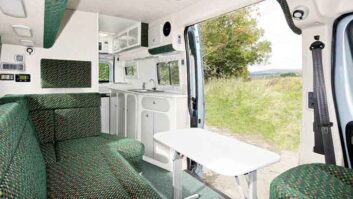I write this from the Practical Motorhome stand at the Boat and Caravan Show (stand 5020) and I’ve just had confirmed to me one of the longest-awaited news stories in motor caravanning’s recent history: Bailey of Bristol is on the verge of launching its first motorhome.
Bailey is one of the UK’s leading tourer manufacturers, with a 60-year pedigree of building well-equipped but keenly priced caravans. There has been talk of their entering the motorhome market for many years, and now a senior source at Bailey has confirmed to me that a prototype motorhome has gone down the production line at Bailey’s Bristol factory, and is currently undergoing track-testing. The aim is to launch the motorhome at the October NEC show this year.
We don’t know much about it yet, but what we do know is that it will make use of Bailey’s state-of-the-art Alu-Tech bodyshell construction method, rolled out across its tourer ranges. Bonded panels such as the sidewall and roof are clamped together with an aluminium extrusion, which is in turn held in place from the inside by a metal connecting bracket. The assembly is then locked together by a T-bolt fixing and a plastic cap covers the fittings so it all looks neat from the inside.
The benefits of this are a stronger shell, and better defence against leaks at the seal where panels join. Bailey’s so confident of its methods that it offers a 10-year bodyshell integrity guarantee for its caravans. Similar techniques have been used in motorhome manufacture down the years, but only in high-end ‘vans built on the European mainland.
So how different is building a tourer to building a motorhome?
The on-road flexes, stresses and strains on the motorhome’s habitation body are different, so the union of caravan body to chassis is crucial. As is the volume of noise from the furniture and interior fittings: you don’t worry a jot about clattering grill pans, flapping locker doors with no bump stops, or the tweets and twitters from furniture and cassette blinds when you’re towing a caravan.
Then there are the floorplans: layout is the most important consideration when it comes to buying a motorhome, and the requirements of caravanners and motorcaravanners are often very different. Motorhome floorplans need to make cleverer use of more limited internal space. A-class motorhomes and, increasingly, low-profiles have pull-down ceiling beds, so they take up no internal floorspace when they’re not in use: no UK volume manufacturer has risen to this challenge as yet. Will Bailey be the first?
Weights and payloads are important when it comes to matching car and caravan outfits, but the 3500kg maximum technically permissible laden mass figure is becoming increasingly important in motor caravanning circles. Anyone who passed their driving test after January 1997 needs to take a medical and re-test in order to gain a C1 licence category, and so drive a motorhome with an MTPLM of more than 3500kg: so there’s a generation of potential motorcaravanners, currently in their 30s, for whom weight will one day be a crucial factor in joining our hobby, and as time goes on, this number will only grow. It’s a similarly crucial figure for those aged over 70.
These are all considerations Bailey has no doubt taken into account. And when it comes to manufacturing and marketing, recent history shows that there are few businesses in our industry smarter than Bailey. I’m told safety and security will play a key part in the thinking behind their motorhomes, that they’ll be packing them with strong equipment levels and offering them at a keen price.
I for one am hugely excited at the news of a Bailey motorhome on the horizon. It could bring a new set of ideas, innovations and thinking to our hobby, and widen the choice for motorcaravanners.
We’ll be following the progress of Bailey’s motorhome development closely in the coming months and in the run-up to launch. Watch this space to be first with the news!
Rob Ganley, editor







